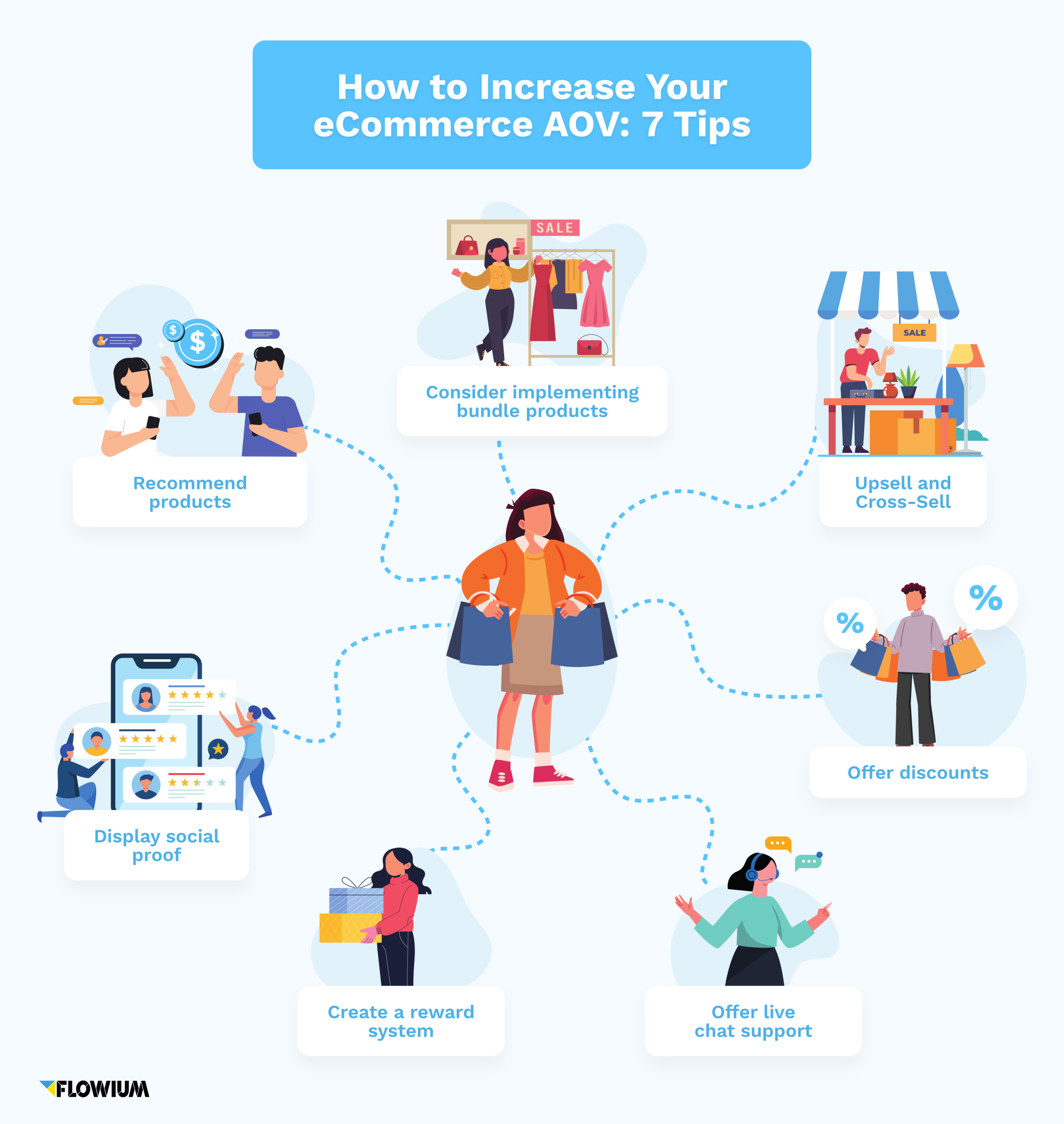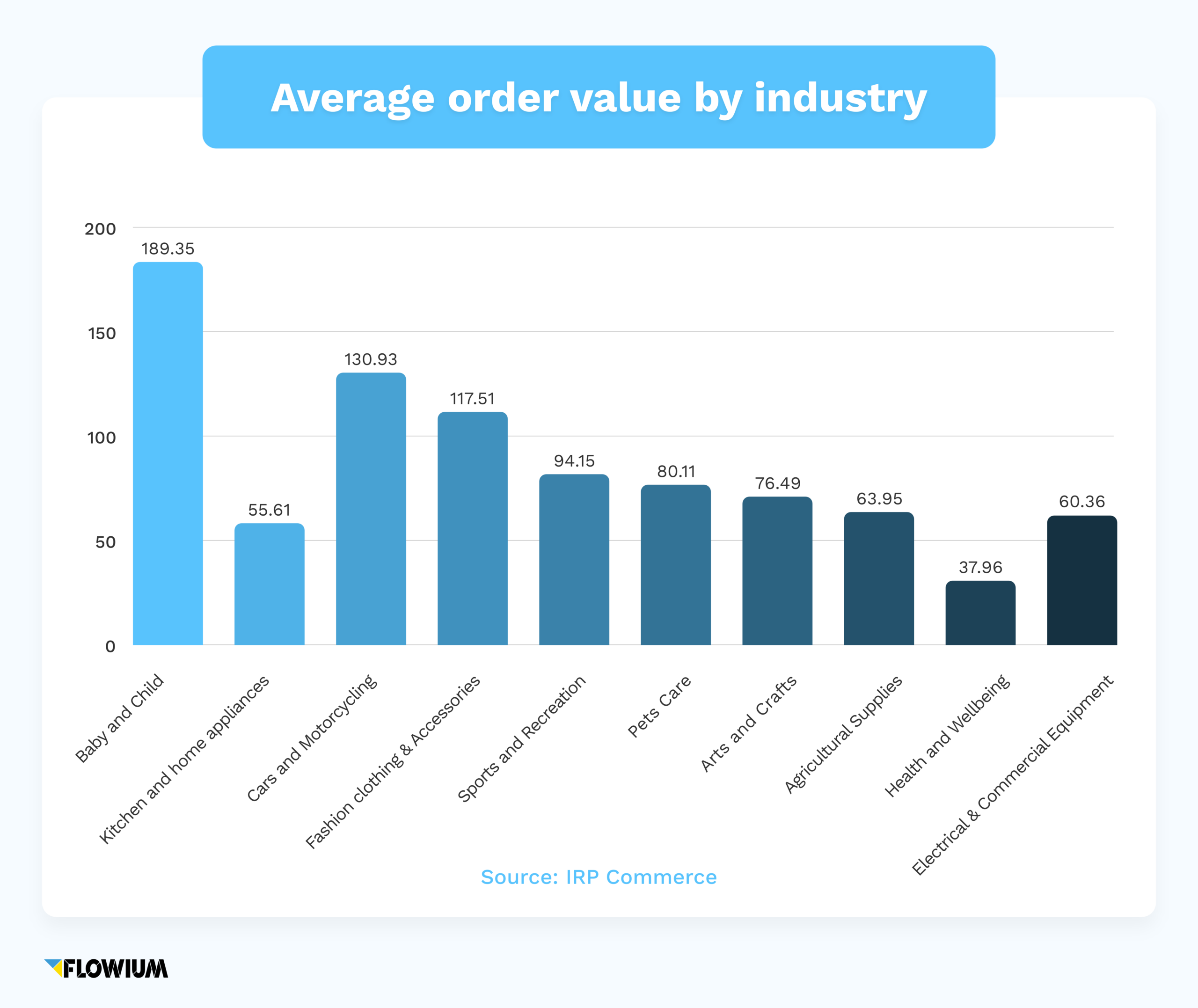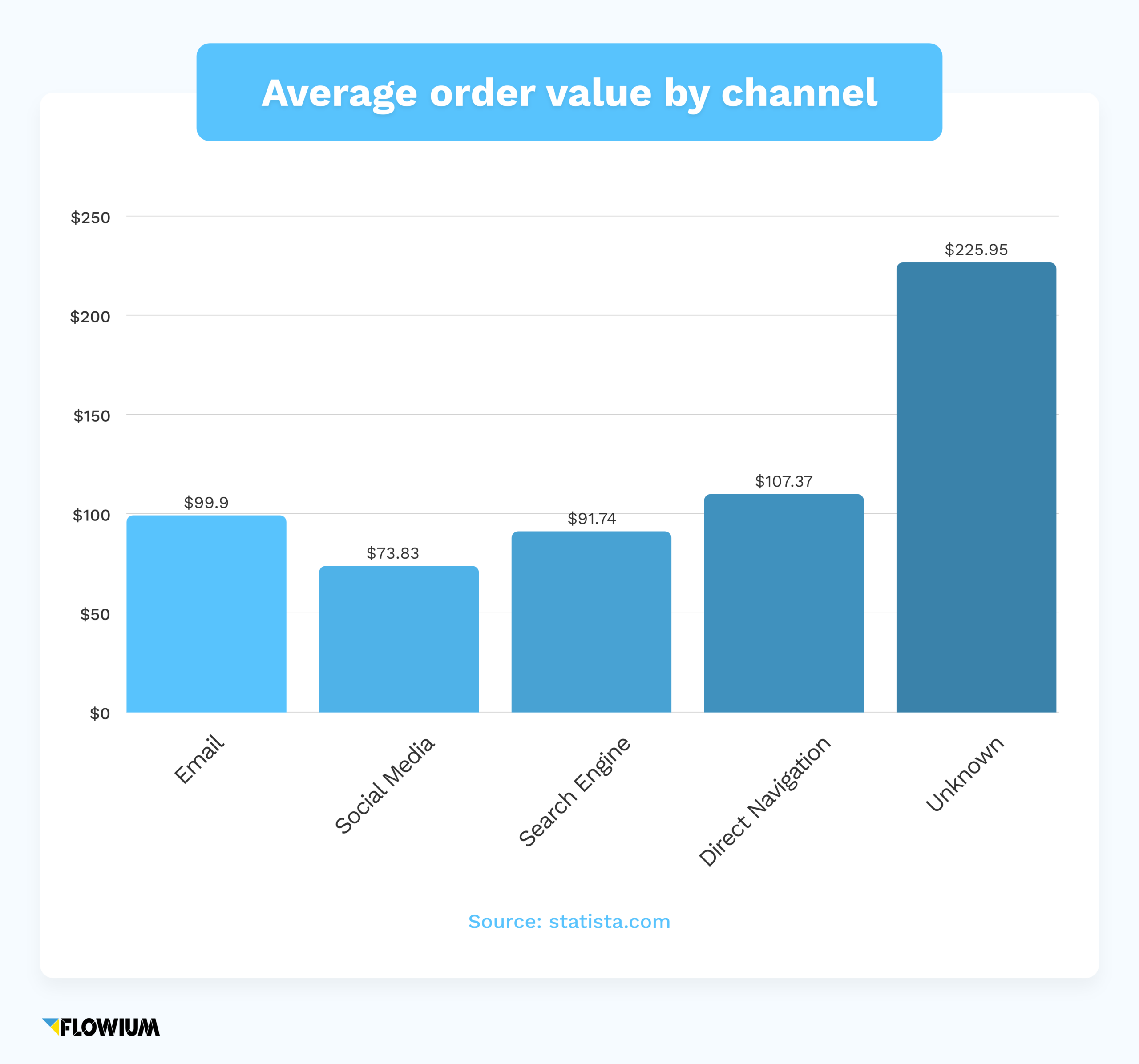You’ve finally succeeded in increasing traffic to your eCommerce website. Even better, your conversion rates are going through the roof, or at least very satisfactory. But then, you go through your business metrics and notice your average order value (AOV) is relatively low.
Does this sound like you? Well, you’ve come to the right place.
This article walks you through seven power strategies to help you get your eCommerce average order value from where it is to where you want it to be. You’ll also discover insight into how vital your AOV is to your business and some statistics that can help you understand where you are as a brand.
Remember, the primary goal of increasing your average order value is so that you can make more money per transaction, which in turn widens your profit margins. In a few moments, we’ll share some tips on doing this.
But first, let us examine what average order value is and how it impacts your business goals.
AOV: Meaning and Relevance

AOV stands for average order value and is the average amount your customers spend when purchasing from your eCommerce store.
Now, as an eCommerce store owner, you undoubtedly want your business to generate maximum returns. This is because while many other relevant metrics help to measure and maximize this goal, the AOV is the only one that tracks how much your customers spend per order.
The average order value tracks the average amount spent whenever a customer places an order using your website or application. This can give you insight into various aspects of your eCommerce, including your most popular products, your customers’ purchasing habits, and more.
For instance, a lower AOV usually indicates that your average customers prefer to make small purchases when placing orders. As a business owner, seeing these numbers will, in turn, influence essential business strategies such as product pricing and marketing campaigns.
💡 Remember, the goal is to increase AOV and get higher revenue returns.
Let’s express the average order value in terms of numbers.
Assuming you sell 500 products in a month and generate a revenue of $2500, your average order value (AOV) for that month is $50.
In other words, this is the average amount a customer spends for each purchase from your website.
You can directly improve profit and business revenue by measuring, tracking, and applying strategies to help increase this value.
More importantly, when you understand how much your customers are willing to spend on your website, you can begin to gain insight into the perceived value of your products and leverage that knowledge to improve your business.
How to Calculate Average Order Value
Before you can calculate your eCommerce’s AOV, you need to know your total revenue for the given period and the total amount of orders. Using these two numbers, you can then calculate your average order value.
Mathematically, you calculate using this average order value formula:
Average order value = Total revenue/No of orders.

For example, assume you had a revenue of $50,000 from 2500 orders in February. Using the AOV formula, we divide $50000 by 2500. Therefore, your AOV for February is equal to $20.
You can then compare this number to your previous AOV and your industry’s benchmarks. In addition, you want to compare it to other key performance indicators like your conversion rate, customer lifetime value, etc.

💡 As a rule of thumb, you want your average order value to be as high as possible. This way, you can be sure you’re getting impressive returns on your marketing and advertising efforts and other investments you’re making to help your eCommerce grow.
What is the Importance of AOV in eCommerce?
Undoubtedly, your eCommerce’s AOV is an essential metric to track. But why is that?
Your average order value is one of the important KPIs as it helps provide insights into the customers’ buying patterns and your pricing strategy.
By monitoring, analyzing, and increasing your AOV, you can increase your return on investment (ROI) and Return On advertising Spends (ROAS).
You see, your average order value is crucial to calculating your business revenue.
How?
Revenue = number of visitors x conversion rate x average order value.
Therefore, without your AOV, it may be challenging (if not impossible) to come up with accurate numbers for your eCommerce revenue. Besides, your average order value also plays a role in planning and executing a surefire eCommerce optimization strategy.
Here is some more information on the relevance of your AOV to your business:
It helps in discovering buying patterns and trends
By measuring your AOV, you can find the buying patterns of your customers.
Because buying habits change by season and what is currently trending, it makes sense to know how this affects your sales revenue.
For instance, an increase in AOV during a festive period is indicative of a campaign and a particular type of product that best resonated with your customers that season.
On the other hand, a decrease can help you understand what you are doing wrong with your pricing or the kind of campaign you are pushing out.
This knowledge will, in turn, form the basis for future festive campaigns and help you make the most of each season and trend.
It helps you understand returns on ad spend
How much are you spending on paid ads, and how is it affecting your AOV?
These are factors to consider when measuring returns from your advertising investment.
For example, if your AOV is $40 and you are spending $40 or more to acquire each customer, then there is something you need to do better.

It helps develop a great pricing strategy
Having clear insight into your AOV better equips you to adjust your eCommerce pricing in the best way possible.
In other words, you won’t be randomly placing a price on your products. Instead, you understand how well it will affect your business profit.
Now that we know how important the AOV is to your eCommerce, let’s explore what a good average order value is.
What is a Good Average Order Value?
There is no hard and fast rule for average order value benchmarks.
Nonetheless, some industry standards can give you comparative insight to help you decide if you need to make critical changes to your eCommerce strategies or not.
However, you have to consider factors such as your industry, your particular market, your sales channel, etc., when making AOV comparisons.
An excellent approach to your average order value is to aim to surpass your previous one, regardless of whether it is on a monthly or yearly basis. So, irrespective of your current AOV, as long as you focus on topping your current numbers, you’re on the right track.
Let’s examine some top strategies to increase your eCommerce AOV and smash your AOV goals.
How to Increase Your eCommerce AOV
There are a ton of schemes that claim to help you increase your eCommerce’s average order value. Unfortunately, not all of them are practical or effective.
But, here are some proven strategies targeted at getting your customers to increase the value of their purchases:

1. Offer discounts on your products
Over the years, discounts have proven to be one of the most effective ways to encourage more purchases and invariably increase your average order value.
An excellent strategy for creating discounts for your products will be to create a minimum spend on all orders.
For instance, you can offer a 30% discount when they buy 3 of the same or different items.
Another approach is to offer an amount off when they cross a spend threshold. Here is an example: ‘Get $15 off when you buy goods worth $150.’
This strategy creates a fear of missing out (FOMO) — a marketing tactic that spurs customers to make purchases because they don’t want to miss out on good deals.
2. Create a reward system for loyal customers
Creating a reward system can be a great way to build a loyal relationship between you and your customers and encourage them to return to your store for more purchases.
More importantly, loyal customers are more likely to buy more products per shopping session.
💡 By setting up a customer loyalty program that tracks your customers’ shopping habits and rewards loyal ones, you can get them to come back repeatedly.
For instance, you can set up a basic point program where a customer earns points for each dollar spent in your store. These points can then be accumulated and redeemed to get discounts and promotions.
Another method is to create a loyalty program that rewards customers based on how much they spend. This can be in tiers with different perks offered depending on their level.
3. Upsell and Cross-Sell Products
In eCommerce, cross-selling and upselling is a surefire way to get more sales and increase average order value.
With cross-selling, you are inviting your customers to buy complementary products in addition to the purchase they have made.
For example, you could encourage a customer to buy a phone case to complement the mobile device they have added to their cart.
However, you have to take the time to identify products that complement the original item your customer is interested in. An excellent way to ensure this is to display a ‘customer also bought’ section on your product page or even on your checkout page.
This way, customers become aware of products or options they didn’t know about before.
On the other hand, upselling is when you showcase a similar but higher-priced product than the one in question. By showing customers products that will better fulfill their needs, you offer increased value while increasing your AOV.
For instance, you could show a customer looking at a 32GB phone how they would be better satisfied with a phone that has a 62GB storage capacity.

4. Display social proof of previous purchases
Generally, people are more likely to make purchases (and buy more) if they see that other people have bought similar products and are satisfied with their items. So, it’s no wonder social proof is an effective way to encourage larger buy orders and increase your AOV.
Statistics have shown that most people look out for reviews and recommendations from others who have had an experience buying from an eCommerce business before buying themselves.
Therefore, displaying social proof from your existing customers can encourage new people to trust and patronize your business. Furthermore, new and current customers are more likely to buy more if they see you are a trusted brand many people love.
That said, one of the best ways to display social proof is by including user-generated content in your product images. Also, you could include ratings and reviews on your website and your social media pages to help others see what your customers are saying about your business.
Another strategy used by many eCommerce stores is showcasing the number of customers they have served and the number of products/sales they have made.
This helps reassure your new customers that you are trustworthy and sure to deliver.
5. Consider implementing bundle products
Product bundling is a marketing strategy in which multiple products are grouped and sold as a single unit.
This is an effective strategy to encourage your customers to buy more items than they planned to and, in turn, increase your AOV.
Here is how it works — you want to offer a package or bundle of products that cost less than if they were individually purchased. But, you also want to make sure these bundles offer maximum value to your customers.
The goal is to make your customers feel like they are getting a better deal when they buy a bundle of products than buying them individually.
For example, instead of buying just one t-shirt, you could create a bundle offer where they buy a t-shirt, a pair of shorts, and a face cap for a lesser price than it would have been if shoppers bought them individually.
Another great way is to offer your customers the chance to create their bundles for reduced costs.
The best way to create product bundles is to consider your customers’ needs and what will add maximum value to them. You should also check on your competitors’ offers to help you stay on top of your game.
💡 Whatever you do, make sure these are valuable and relevant products to that particular customer.

6. Create a product recommendation section on your website
Here’s how this one works:
Imagine a customer lands on your website and is browsing for a particular product. Then, your recommended product section pops up and displays other products related to their initial intent. Chances are they’ll add some of the new products to their carts as long as they are products that provide value.
With recommended products, it does not matter if they cost more than the products your customer was initially searching for. Instead, makes sure the products you’re suggesting are along the same line of interest as the original product the shopper was considering.
This way, you increase the chances of your shoppers adding more products to their shopping cart before they reach checkout and payment.
Adding a recommended product section to your website effectively showcases your lowest-performing products while also highlighting your best-selling ones.
💡 You can also consider adding a recommended products section to your checkout page. This can be an effective tool to pull in higher order values from impulse buyers and even other shoppers.
7. Offer an efficient and effective live chat support system
A business that is always on hand to respond to the inquiries of its customers has more chances of reducing abandoned carts and converting them.
This is because when your customer can get immediate responses to their inquiries while shopping, they are less likely to drop products due to a lack of adequate information.
For example, a customer that needs more information about your shipping costs might need an immediate answer before completing their purchase.
By responding with no delay, you have better chances of converting such customers, thereby increasing sales for your business and, in turn, your AOV.
Average Order Value Statistics in eCommerce
Knowing your business’s AOV may not be enough. Instead, a better approach may be to stay on top of AOV developments on the eCommerce scene in general. This way, you have an idea of how well your business is doing with regard to your competition and other stakeholders.
Now, what are the average order value statistics in eCommerce?
Well, one size does not fit all. Different factors such as the channel, industry, country, device, etc., can influence average order value in eCommerce.
But, not to worry, we’ll examine the average order value statistics across these variables.
Average order value by online retail
Online retail focuses on the average AOV from customers buying from your online store.
According to surveys, eCommerce stores witnessed a 14% increase in AOV when they implemented customer loyalty programs and campaigns.
In addition, recommended products produce a 40% increase in AOV than return visits for non-recommended products.
Furthermore, loyal customers have a 5% higher average order value than first-time customers.
With these stats, you can begin to focus on what truly matters and are aimed at increasing the average order value for your online retail.
Average order value by industry
According to IRP Commerce, the average order value varies significantly by industry.
Check the graph below to see each value across different industries:

Source: IRP Commerce
Average order value by channel
As an eCommerce owner with customers landing and shopping from your website via different channels, it makes sense to know the specific AOV for each channel.
What this does is that it helps you compare each value and decide the top and less performing ones.
This way, you can discover which of your marketing efforts are working and which ones you need to improve on.
That said, let’s check out the average order value statistics by channel:

Source: statista.com
Average order value by device or platform
Surprisingly, while a significant amount of shoppers now use their mobile phones to make online purchases, the AOV for this platform remains low.
This is, of course, compared to the average order value of other devices like the desktop computer.
According to Monetate, here are the average order value by devices/platforms:

Source: www.monetate.com
Average order value by country
Likewise, average order value differs by country. In the table below, we will list the average order value across three different regions:
| Country | Average Order Value |
|---|---|
| EMEA | $135 |
| America | $128 |
| APAC | $126 |
Source: marketing.dynamicyield.com
Average order value benchmarks
The goal of benchmarks is to help you know how you are performing in comparison to others. In other words, this data works as a guide to help you with your business direction and efforts.
By knowing the standard of performance within your industry, you can set more precise and measurable goals.
For example, a Statista survey showed that orders placed from a desktop had a higher AOV when compared to those placed using mobile phones.
But why should this better matter to you?
Depending on the type of products you sell and your niche, it may be a great idea to optimize your eCommerce website for desktop devices first. This way, you can improve the web experience of your top buyers and even make it easier for you to display offers, promotions, and related purchase incentives on their screens.
However, this is not to say you should ignore customers who shop from their mobile devices.
Key AOV Metrics: What are They?
We have clearly defined that the average order value represents the average amount spent each time a customer places an order on your site. Furthermore, we’ve shown how important it’s to any eCommerce business while examining top strategies to increase your store’s average order value.
Now, let’s consider the critical average order metrics and how to measure each one.
1: AOV KPI
We have already established that the AOV is the average amount a customer spends per order.
As a key performance indicator (KPI), it helps evaluate your pricing strategy and overall marketing efforts.
With AOV, the focus is more on the customers’ behavior and how you can set goals and strategies while accessing how effective those strategies are.
When using AOV as a KPI, it is usually best to compare it with other essential metrics. This provides a more comprehensive picture of what you are doing and how much returns you are getting from your efforts. Otherwise, you may be seeing distorted insights.
For example, suppose the goal is to measure customer satisfaction. In that case, the average order value can be measured against other performance indicators such as the customer lifetime value, conversion rate, revenue per customer, etc.
2: AOV and LTV
LTV, which is the lifetime value of a customer, is the value of a single customer throughout their interaction with your business.
In other words, it is the total revenue generated by a single customer over the entire period of their relationship with your business.
Now, while AOV focuses on the average spending per transaction, with LTV, the focus is on the value of a single customer.
Are you wondering which of these two metrics you should measure and explore? The truth is, they are both important in helping you build and strategize effective marketing campaigns.
💡 Knowing the value of one single customer is key in discovering how much you need to spend on acquiring new ones while satisfying and increasing the value of the existing ones.
The key is knowing when to use each measurement.
For example, if you have a low AOV, then it means you probably need to develop new and effective strategies to help sell more of your higher-priced goods.
On the other hand, your LTV will help you know how much you need to be putting in to acquire new customers to purchase your goods.
For instance, if your LTV is around $500 and you are spending $500 or more to acquire these customers, then there is a need to change strategy.
And because LTV is customer experience focused, strategies can include:
- Providing your customers with great satisfaction to build loyalty
- Creating effective marketing channels
- Offering your customer a personalized experience with your brand
- Improving your customer service
At the end of the day, both metrics will come in handy at different points in time.
In addition, your kind of business will determine which one you focus on the most.
For example, if you sell goods that are usually one-time purchases, such as cars or bridal accessories, you will want to focus on your AOV.
On the other hand, you will need to focus on your LTV if you offer regular purchases such as clothes, etc.
3: AOV vs ACV
ACV is an important metric that represents the Annual Contract Value of your business. It is a measure of the annual value your customer contracts bring in each year.
If you run a company that offers subscription plans, then you might need to measure this metric.
For example, if one customer signs a 3-year contract with your business for $45000, your ACV is $15000.
While the ACV may not be an essential metric by itself, using it with other metrics such as your AOV or your customer acquisition cost may give you a clearer insight into the results you’re getting from your marketing strategies.
💡 Pro Tip? A high ACV is directly proportional to a high CAC, which just means you need to spend more finding high-ticket leads.
On the other hand, a low ACV just means you will need to get more customers.
AOV Analytics Using Google Analytics
When it comes to tracking sales and other customer behavior, it can be quite a hassle having to monitor each one manually.
Thankfully, with Google Analytics, you can experience an easier way of measuring customer data and key metrics to help you know how well your store is doing.
Once integrated with your online store, Google Analytics can help you monitor and assess how your customers are interacting with your site. It measures important metrics such as:
- Transaction rate
- Conversion
- Unique purchases
- Per session value
- Revenue
- And many more.
In this article, we will be focusing on the Average order value analytics using Google analytics.
To allow Google Analytics to provide an insight into our site, you need to follow these steps:
1. Install Google Analytics
The first step is installing Google Analytics and integrating it with your online store.
To do this, you need to first sign up for a Google Analytics account by following the sign-up process.
Once completed, you want to log in to your account and navigate to admin. Next, click on tracking info to copy the tracking code for your website.
The next step is to open the header.php file of your site and then paste it directly after the <body> tag, and click on update.
Another method is to install a plugin like Yoast or the Insert header and footer plugin.
2. Enable eCommerce Tracking
Once installed, enable eCommerce tracking in Google Analytics by clicking on Admin>View>Ecommerce setting.
From here, you need to switch the eCommerce toggle ON to enable Google Analytics to begin to gather data from your site.
3. Add eCommerce tag to tracking code
Wait! We are not done. You still need to add an eCommerce tag to the tracking code you added earlier.
What this does is help initiate the tracking of eCommerce events on your site.
This way, you will be able to get detailed reporting of events such as products added to carts, carts abandoned, checkouts, etc.
To do this, open the tracking code, and on the second line, paste the following code: ga(‘require,’ ‘ecommerce,’ ‘ecommerce.js’);
4. Test! Test! Test!
The final step is to test whether eCommerce tracking is working and whether reports are going to Google Analytics. We recommend you complete a test transaction on your website.
For instance, you can complete an order and check Google Analytics to see if that activity was reported.
Once completed, you can now begin to see your average order value for a given period.
Simply log in to your Google Analytics dashboard, then navigate to Conversions>eCommerce>Sales Performance> Average Order Value.
In addition, you can drill down by using custom segments to help you see what the AOV is on mobile versus desktop.
Average Order Value (AOV) FAQs

AOV is not the only metric you need to be focusing on. As well as looking at your AOV, you also need to monitor other metrics such as the conversion rates, the revenue per visit, etc. These provide a more balanced evaluation of how your business is faring and the strategies you need to apply to make a difference.
Knowing your business’ average order value is key to understanding your customers’ behaviors. With this metric, you are better able to develop strategies that help encourage your customers to purchase your higher-priced goods. It can also provide insight into issues with your pricing strategies.
A low AOV means your transaction revenue is lower than it should be. This might mean you sell more of your lower-priced orders, and your customers aren’t buying the more expensive ones. This tells you to begin to work on your strategies and offer more value to your customers.







